I am trying to linearly interpolate new values from a data set using Apple's Accelerate framework. I've used this piece of documentation for implementing my code, but I am facing issues when I try to interpolate a set of values that are under 1, fractions.
let values: [CGFloat] = [0.0, 0.019124083, 0.035419375, 0.05232375, 0.06873629, 0.08550575, 0.10209821, 0.11870141, 0.1355003, 0.15223834, 0.16881292, 0.18565933, 0.20213126, 0.21881929, 0.2355565, 0.2522735, 0.26899675, 0.28572345, 0.30233976, 0.3187645, 0.33557975, 0.35221455]
let indices: [CGFloat] = [0.0, 0.00438118, 0.017873764, 0.04094696, 0.07394123, 0.11698151, 0.16987896, 0.23201275, 0.30223083, 0.37879562, 0.45942688, 0.54145336, 0.6220541, 0.6985626, 0.7687006, 0.8307409, 0.88353443, 0.9264679, 0.95935345, 0.98232174, 0.9957142, 1.0]
let numberOfElements = vDSP_Length(100)
var result = [Float](repeating: 0,
count: Int(numberOfElements))
let stride = vDSP_Stride(1)
var base: Float = 0
var end = Float(values.count)
var control = [Float](repeating: 0,
count: Int(numberOfElements))
vDSP_vgenp(values, stride,
indices, stride,
&result, stride,
numberOfElements,
vDSP_Length(values.count))
print(result)
// [0.0, 0.35221455, 0.35221455, 0.35221455, 0.35221455, 0.35221455, 0.35221455, 0.35221455, 0.35221455, 0.35221455, 0.35221455, 0.35221455, 0.35221455, 0.35221455, 0.35221455, 0.35221455, 0.35221455, 0.35221455, 0.35221455, 0.35221455, 0.35221455, 0.35221455, 0.35221455, 0.35221455, 0.35221455, 0.35221455, 0.35221455, 0.35221455, 0.35221455, 0.35221455, 0.35221455, 0.35221455, 0.35221455, 0.35221455, 0.35221455, 0.35221455, 0.35221455, 0.35221455, 0.35221455, 0.35221455, 0.35221455, 0.35221455, 0.35221455, 0.35221455, 0.35221455, 0.35221455, 0.35221455, 0.35221455, 0.35221455, 0.35221455, 0.35221455, 0.35221455, 0.35221455, 0.35221455, 0.35221455, 0.35221455, 0.35221455, 0.35221455, 0.35221455, 0.35221455, 0.35221455, 0.35221455, 0.35221455, 0.35221455, 0.35221455, 0.35221455, 0.35221455, 0.35221455, 0.35221455, 0.35221455, 0.35221455, 0.35221455, 0.35221455, 0.35221455, 0.35221455, 0.35221455, 0.35221455, 0.35221455, 0.35221455, 0.35221455, 0.35221455, 0.35221455, 0.35221455, 0.35221455, 0.35221455, 0.35221455, 0.35221455, 0.35221455, 0.35221455, 0.35221455, 0.35221455, 0.35221455, 0.35221455, 0.35221455, 0.35221455, 0.35221455, 0.35221455, 0.35221455, 0.35221455, 0.35221455]
